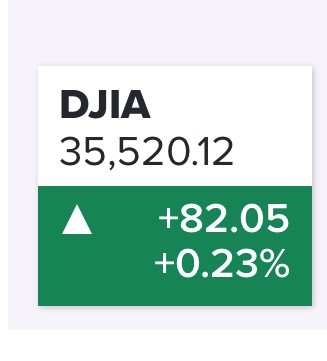Client Question: Dow Jones Industrial Average
July 27, 2023
Last week, a client asked about the NASDAQ 100 and its rebalance. This week, I was talking to a client about the Dow Jones Industrial Average (DJIA). This long-standing market index just posted its best winning streak since the 1980s, posting 13 straight days of positive closes (it fell short of 14 straight days by closing down on July 28, 2023)

As noted in last week’s post, market indexes are used as a way for market participants to track the market’s progress and to benchmark/compare their own performance. They’re also used as a way for investors to easily “buy” large swaths of the market as countless investment products such as exchange traded funds and index mutual funds are structured and pegged to these indexes.
When was it created?
The Dow Jones Industrial Average (DJIA) was created in 1896 by Charles Dow and his business partner Edward Jones to serve as a barometer of the broader US Economy. This makes it the second-oldest index (next to the Dow Jones Transportation Index)
How is it comprised?
The DJIA is comprised of 30 of the top “blue chip” companies in the US. (A Blue Chip company is a well-recognized, well-established, and financially sound company. They generally sell high-quality, widely accepted products/services, have strong brands, and profitable operations).
How is the index calculated?
Unlike the NASDAQ and the S&P 500 (which are market-cap weighted), the DJIA is a price-weighted index. This means that the higher price per share a constituent has, the greater the weight it has in the index. When the index was first created, it was a simple average of 12 stocks and their prices (ie: sum of the 12 prices divided by 12. That formula was adjusted over time and now the index is calculated as the sum of the price one share of stock of its 30 constituents, divided by the “dow divisor” (a preset constant meant to represent a 1 point move in any of the 30 stocks. Right now, the divisor is ~0.15).
Can the constituents change?
Yes, and they have. As companies and the economy evolve, various changes to the index have been made
What companies are in the index?
Here is the current list (as of July 2023)

Should I monitor this index?
Given the history of the index and its ever-present nature in market coverage, many view this index as a key barometer of the market and the economy. It’s often the index quoted in news stories and headlines. However, for investors that are focused on other specific areas of the market – such as technology companies as an example – may find more relevance in other indexes such as the NASDAQ. Or those looking for a broader measure may look to the S&P 500 (which has 500 companies vs. 30).
In short, there is no harm on following a variety of indexes. Just be sure to understand what the index measures and how it’s comprised so you can understand the relevance and correlation it has to your own portfolio.
Leave a note